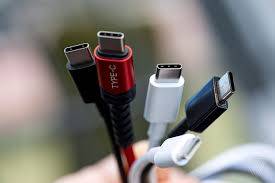**New EU Rules on Common USB-C Chargers to Come into Force**
In a landmark move aimed at reducing electronic waste and improving convenience for consumers, the European Union (EU) has introduced new regulations mandating the use of USB-C chargers as a common standard for a wide range of electronic devices. These rules, set to come into force in late 2024, will require manufacturers to adopt USB-C as the universal charging port for smartphones, tablets, laptops, and other portable electronics sold within the EU.
The legislation is being hailed as a significant step toward sustainability and consumer protection, with implications that could ripple across the global technology industry.
### **What the New Rules Entail**
The EU’s directive requires all electronic devices falling under the regulation to feature a USB-C charging port. This includes popular categories such as:
- Smartphones
- Tablets
- E-readers
- Digital cameras
- Headphones and headsets
- Handheld gaming consoles
- Laptops (from 2026 onward for certain categories)
The rules also stipulate that manufacturers must allow customers the option to purchase devices without bundled chargers, further reducing waste.
The legislation is part of the EU’s broader push to establish uniform standards across the bloc, ensuring interoperability of chargers and cutting down on the millions of tons of electronic waste generated annually.
### **Rationale Behind the Move**
The EU has long been advocating for a common charger standard, citing environmental concerns and consumer frustration with incompatible charging solutions.
According to the European Commission, unused and discarded chargers account for over 11,000 tons of e-waste each year. The proliferation of proprietary charging ports, such as Apple’s Lightning connector, has further exacerbated the issue by forcing consumers to buy multiple chargers for different devices.
“After more than a decade of pushing for this initiative, we are finally delivering on our promise to simplify the lives of consumers and reduce unnecessary waste,†said Thierry Breton, EU Commissioner for the Internal Market.
### **Impact on Consumers**
The new rules are expected to have a significant impact on consumers in the EU and beyond. Key benefits include:
1. **Convenience**: Consumers will no longer need to carry multiple chargers for different devices. A single USB-C cable will suffice for most electronic gadgets.
2. **Cost Savings**: The option to buy devices without bundled chargers will save consumers money and reduce clutter.
3. **Sustainability**: By minimizing e-waste, the rules contribute to a cleaner environment and promote sustainable consumption.
Consumer advocacy groups have widely praised the move, describing it as a victory for consumers who have long grappled with compatibility issues and unnecessary expenses.
### **Challenges for Manufacturers**
While the new rules are a win for consumers and the environment, they pose challenges for some manufacturers, particularly those with proprietary charging systems.
Apple, for instance, has been a vocal opponent of the legislation. The tech giant’s devices currently rely on its exclusive Lightning connector, which will need to be replaced with USB-C ports to comply with the EU’s rules.
Critics argue that the regulations could stifle innovation by mandating a single standard. However, the EU has countered this claim, stating that the rules leave room for future advancements, as long as they maintain compatibility with USB-C.
For smaller manufacturers, the transition to USB-C may involve additional costs for redesigning devices and updating production processes. Despite these challenges, industry analysts believe that most companies will comply, given the EU’s influence as one of the world’s largest markets.
### **Global Implications**
The EU’s decision is likely to have a ripple effect beyond its borders, as global manufacturers often align their products with EU standards to streamline production and avoid fragmentation.
Tech companies may adopt USB-C as a universal standard across all regions to simplify supply chains and reduce manufacturing costs. This could lead to a de facto global standard for chargers, benefiting consumers worldwide.
The move also underscores the EU’s role as a global leader in setting regulations that prioritize environmental sustainability and consumer welfare.
### **Industry Reaction**
Reactions within the tech industry have been mixed. Some companies have welcomed the move, seeing it as an opportunity to simplify product designs and improve user experiences.
Others, like Apple, have raised concerns about the potential impact on innovation and compatibility with existing ecosystems. However, Apple has already begun transitioning to USB-C for some of its devices, such as the iPad Pro and MacBook series, signaling its readiness to adapt to the new rules.
### **Looking Ahead**
As the rules come into force, consumers can expect a more streamlined charging experience and reduced environmental impact. For manufacturers, the transition to USB-C represents both a challenge and an opportunity to align with global sustainability goals.
The EU’s decision also sets a precedent for other regions to follow suit. Policymakers in countries like India and Brazil are reportedly considering similar measures to address e-waste and consumer convenience.
### **Conclusion**
The introduction of common USB-C charging rules marks a transformative moment for the electronics industry and its consumers. By standardizing chargers, the EU has taken a bold step toward reducing e-waste, saving costs for consumers, and fostering a more sustainable future.
While challenges remain for manufacturers, the long-term benefits of the legislation are expected to outweigh the initial hurdles. As the rest of the world watches the EU’s progress, this move could pave the way for a global standard in charging solutions, benefiting millions of consumers and the planet alike.


